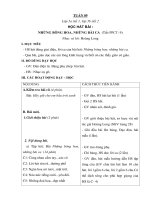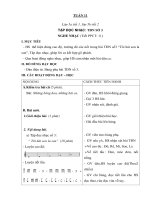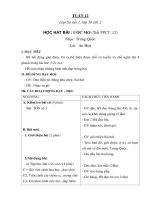sUNIT 5. ONLINE FACILITATION LESSON 5. FACILITATION TEC pptx
Bạn đang xem bản rút gọn của tài liệu. Xem và tải ngay bản đầy đủ của tài liệu tại đây (1.12 MB, 10 trang )
5. Online Facilitation - 5. Facilitation techniques - page 1
Information Management Resource Kit
Module on Building Electronic
Communities and Networks
UNIT 5. ONLINE FACILITATION
LESSON 5. FACILITATION TECHNIQUES
© FAO, 2006
NOTE
Please note that this PDF version does not have the interactive features
offered through the IMARK courseware such as exercises with feedback,
pop-ups, animations etc.
We recommend that you take the lesson using the interactive courseware
environment, and use the PDF version for printing the lesson and to use as a
reference after you have completed the course.
5. Online Facilitation - 5. Facilitation techniques - page 2
At the end of this lesson, you will be
able to:
• identify the principal facilitation
techniques for managing online
discussions.
Objectives
Introduction
Facilitation of an online discussion is for
the most part the application of
techniques.
This lesson introduces some of the main
facilitation techniques to help you
develop an overall approach to meet the
specific needs of your community.
5. Online Facilitation - 5. Facilitation techniques - page 3
Some facilitation techniques may work out differently, depending on the particular situation.
It is important to keep a constant check on your own values and assumptions as well as possible
cultural sensitivities among the participants.
Knowing how to apply facilitation techniques at the right time and in the right way is something that you
will learn by experience.
For instance:
• You may need to deal with some participants and their
contributions in a particular way because of their status, gender,
age or communication style;
Introduction
Example 1 - If the community includes both senior
managers and more junior staff, you may need to
emphasize that everyone has a "right" to participate in the
discussions, and make special efforts to encourage junior
staff to make their voices heard.
• The topic of discussion may also influence your use of
facilitation techniques.
Example 2- A discussion on "HIV/AIDS and food security"
may touch on religious or cultural taboos as well as on
participants' personal circumstances, and will need particularly
sensitive facilitation.
Introduction
The most important techniques, which apply to most facilitation situations, are the following:
• Listening/reading;
Let’s analyse them in detail…
• Composing and editing messages;
• Asking and answering questions;
• Clarifying; and
• Summarizing and synthesizing.
5. Online Facilitation - 5. Facilitation techniques - page 4
Listening/reading
Listening/reading is the most important facilitation technique.
As a facilitation technique, listening implies:
• listening to what is “said” (written),
but also to how it is “said”;
• reading between the lines, understanding
what is not said directly;
• interpreting silence. People may not
respond because they agree or they don’t
understand, or maybe because they are upset.
Why silence happens
Silences in your online community can indicate that members…
• are at a loss as to how to continue;
• feel they have nothing to say;
•are busy;
• are silent because they feel shy or intimidated;
• are not yet a cohesive group and diversity in the group is silencing some (for example language
issues, or rural/urban, or unequal comfort with technology);
• do not have regular access to their e-mail;
• they are in agreement.
Composing and editing messages
As long as online discussions are mainly text-based, writing clear and unambiguous
messages is key to preventing friction and misunderstanding in your online community.
As a facilitator, you need to compose messages in an appropriate way and help
participants in learning how to do the same (for example, using your group’s discussion
guidelines).
In order to compose a clear message, take into
account the following suggestions about its
length and content:
• keep messages short and to the point and
include only relevant parts of the message you
are replying to;
•use a descriptive subject heading or keep
the same subject heading if you are replying to
a message (see box);
•use unaccented text (i.e. do not use
“special” characters such as é, ñ, ¿ because
some people’s computers will not display these
letters and punctuation marks correctly); and
• put one key idea per message, don’t overfill
your post with too many issues or ideas. Most
people only take in the first one.
Subject headings
If participants make mistakes with
the subject headings, in a moderated
group the facilitator can choose to
rename them in order to organize
messages under the same subject
heading.
5. Online Facilitation - 5. Facilitation techniques - page 5
Sometimes you may be tempted to re-edit the
content of a message, for example because
you might think that it is not clear enough…
Editing someone else’s message without
that person’s explicit permission is not
recommended!
You can reject a message on the basis of the
discussion guidelines and:
• send it back to the originator with a reference
to the discussion guidelines;
• send it back to the originator and suggest
discussing how the message can be edited in
order to be more acceptable.
Composing and editing messages
Asking and answering questions
When the participants are not very familiar
with each other yet, it is sometimes easier to
respond to questions about other people and
other situations than questions about their
personal experiences and about this online
community…
• Ask questions about past experiences or
joint experiences in order to build
common ground;
• Ask questions about past experiences or
joint experiences in order to build
common ground;
• Ask participants to respond to something
you know they may not agree with; and
• Ask participants to respond to something
you know they may not agree with; and
• Ask questions that are directly connected
with the topic under discussion, this will
help to keep the discussion focused.
• Ask questions that are directly connected
with the topic under discussion, this will
help to keep the discussion focused.
Questions and answers is a technique to get or to keep a discussion going. Asking good
questions makes it easy for participants to respond.
Keep the number of questions in a single message to 2-3 maximum. Asking a lot of
questions in a single message can be overwhelming to people, and they may not respond.
5. Online Facilitation - 5. Facilitation techniques - page 6
• open-ended, tend to start with "how",
"what", "when", "where” and are used to
stimulate an answer that doesn’t stop at
"yes" or "no", but must be more
extensive;
• clarifying, tend to start with "which",
"why", "do you mean to say ” etc. and
are used in order to clarify concepts; and
• closed, used only occasionally, can be
answered with "yes" or "no" and are
posed to get specific information.
Why do you agree or disagree with
this statement?
How do you understand today’s task?
Do you mean to say that you agree
with this statement?
Is the task for this session clearly
understood?
Does everyone agree on the priority
for today’s task?
Does everyone understand the task
for this session of our discussion?
The facilitator can ask different kind of questions:
Asking and answering questions
Asking good questions
/>Clarifying
Before you can summarize or synthesize,
you may need to make sure that everyone
understands the ideas or opinions in the
same way. If you feel there might be
some points of misunderstanding, it is
important to test for understanding and
clarify ideas or opinions if needed.
Seeking clarification is important,
especially if you need to build consensus
around the use of important concepts or
when there seems to be a
misunderstanding between participants.
5. Online Facilitation - 5. Facilitation techniques - page 7
There are several ways to ask for clarification:
Clarifying
• paraphrasing: restating an idea or point in your own words, in
a clear manner. Paraphrased text is often also shorter than the
original text. Paraphrasing is a good technique to check the
meaning of an idea with the sender of the idea or opinion;
• paraphrasing: restating an idea or point in your own words, in
a clear manner. Paraphrased text is often also shorter than the
original text. Paraphrasing is a good technique to check the
meaning of an idea with the sender of the idea or opinion;
• restating: ask participants to restate their opinions or ideas
using different words;
• restating: ask participants to restate their opinions or ideas
using different words;
• illustrating: ask participants to give examples to illustrate their
ideas or opinions.
• illustrating: ask participants to give examples to illustrate their
ideas or opinions.
Keeping information gateway content regularly updated is much easier if the editor responsible for a topic is either
working directly in the area, or personally passionate about it. If you know the topic thoroughly, are active in the
area, and are subscribed to a lot of relevant listservs and newsletters finding new resources is not a chore. In general
new resources come to you, you check them out as part of your "normal" work, and add them to the portal. From
time to time you search for new materials, but the searching is easier because you have a clear framework for
formulating your search. By contrast, if an editor is *not* personally or professionally active in the topic for which
they are responsible regular updating becomes more difficult, and the contributions are likely to be of a lower quality.
A has said that it's easier to keep the content of your portal updated if editors are responsible for topics they work
with on a daily basis, so they come across new content regularly, or if they are personally passionate about the topics.
If they are not "involved" with the topics they are less likely to update content actively and accurately.
What I'm trying really trying to say is if that if editors don't keep up-to-date with the topics covered in "their" section
of the portal - either because it's part of their jobs, or because they have a burning personal interest - your site won't
be great.
For example, the "building online communities" section of our portal is maintained by a volunteer. She's doing
research on online communities, and constantly comes across new resources, so that section of the site is really
dynamic. On the other hand, I maintain the section on web development - and I don't have time to keep up-to-date
with developments, so that section is not updated as often as it should be.
Paraphrasing, restating, illustrating
Original text (participant A):
Paraphrased text (facilitator)
Restated text (participant A):
Illustrated text (participant A):
Clarifying
5. Online Facilitation - 5. Facilitation techniques - page 8
Click on each option, drag it and drop it in the corresponding box.
When you have finished, click on the Check Answer button.
Summarize, synthesize, and ask the
community if this represents the
discussion.
Clarify concepts, paraphrasing the
statement.
Use questions and answers to provoke
responses.
Match each facilitation technique with a situation in your online community…
The discussion on a topic seems stuck on
two opinions and you want the community
to move on to the next topic.
The online meeting has started and the
agenda has been approved, but there
are no responses to the presentation of
agenda point 1.
A participant has posted a message
with a statement that can be
interpreted in different ways.
Clarifying
Summarizing and synthesizing
Summarizing and synthesizing are
important techniques in online meetings
and conferences:
• summarizing is putting the main ideas
and points of a discussion or text in your
own words (summaries are significantly
shorter than the original texts); and
• synthesizing is bringing two or more
ideas or points together into one new idea
or point.
Summarizing and synthesizing help to
bring a discussion around one topic to a
close in order to move on to the next
topic.
5. Online Facilitation - 5. Facilitation techniques - page 9
“I like the idea of a brochure. My cousin is on the
board of the beekeepers’ association. At
conferences and meetings she brings the
association’s brochure. It has some very beautiful
pictures of how the honey is produced. She talks
to everyone and actually met some people who
now sell the association’s honey.”
“
I don’t like the idea of a handout.
Not everyone who receives it will
be interested in our association. It
will just be a waste of money (and
our efforts). I was thinking more of
a Web site. Everyone can see it
and it hardly costs anything.”
Participant A writes:
Participant B writes:
Please write your answer in the input box and press “Check Answer”.
1) The first common thread might be about the effective use of resources in producing a
handout in the outreach campaign or it might be about understanding how your target gets
information.
2) The second common thread it could be about who will be reached by the campaign or about
researching how other organizations have done their communications.
A group of people are discussing a new outreach strategy for the National Association
of Dairy Farmers. Try to identify the common threads - ideas or points - in the following
texts…
Summarizing and synthesizing
Looking again at the posts of
Participant A
and
Participant B
in the discussion about a
new outreach strategy for the National Association of Dairy Farmers: now, try to
summarize their content and tie them together.
“I like the idea of a brochure. My cousin is on the
board of the beekeepers’ association. At
conferences and meetings she brings the
association’s brochure. It has some very beautiful
pictures of how the honey is produced. She talks
to everyone and actually met some people who
now sell the association’s honey.”
“
I don’t like the idea of a handout.
Not everyone who receives it will
be interested in our association. It
will just be a waste of money (and
our efforts). I was thinking more of
a Web site. Everyone can see it
and it hardly costs anything.”
Participant A writes:
Participant B writes:
Please write your answer in the input box and press “Check Answer”.
The two posts tied together show that both participants say something about the costs and the
effectiveness of a handout. Participant B mentions something very important for this discussion: his
cousin’s association has a brochure with nice pictures which has helped her connect with people.
This increases the effectiveness of the handout.
Summarizing and synthesizing
5. Online Facilitation - 5. Facilitation techniques - page 10
Summary
The main task of a facilitator during an online meeting or discussion is using
facilitation techniques to move the group towards reaching its objectives.
The principal facilitation techniques are:
– Listening;
– Composing and editing messages;
– Asking and answering questions;
– Summarizing and synthesizing;
– Clarifying.
If you want to learn more…
King, M. ; Cowan, R. Tips on Facilitating a Social Change E-mail List
/>ITrain. Mailing list facilitation: How to support people working together online
/>ITrain. List Facilitation; Community of Practice
/>Full Circle Associates. Online Community Toolkit.
/>James, M. and Rykert, R. From Workplace To Workspace: Using Email Lists to Work
Together
/>McNamara, C. Group Dynamics: Basic Nature of Groups and How They Develop
/>Reich College of Education , Asking good questions.
/>









